Editor's note: Late in August the National Park Service released the Revisiting Leopold report, a 23-page report summoned by Park Service Director Jon Jarvis to update the original Leopold Report overseen by A. Starker Leopold in 1963 and bring the agency's approach to natural resources management in the parks up to date. While those close to the report believe its goals can be accomplished, not everyone shares that optimism. The following guest column was written by Daniel Botkin, a lifelong naturalist who for a time sat on the NPS Advisory Board Science Committee that wrote the Revisiting Leopold report, and Alfred Runte, an environmental historian who specializes in the national parks and protected lands.
As readers of the National Parks Traveler are well aware, on August 25, 2016, the National Park Service will be a century old. In anticipation, on August 25 of this year, the agency released the report of a special advisory committee on the role of science in the parks. That report called for more support of science, more scientists on park staffs, and a scientific oversight committee.
As laudable as those recommendations may be, our point is that the larger issue is still not addressed. Yes, science remains an important foundation for managing our national parks. However, not even science will save the parks if they lose their fundamental asset: simply, an abiding respect for open space.
America’s sheer size is what allows us spacious parks. Thus the founding fathers answered the art and architecture of Europe by touting the unrivaled beauty of North America. As defined by Thomas Jefferson in his Notes on the State of Virginia, natural wonders were our identity. Especially at Harpers Ferry, where the Potomac River pierces the Blue Ridge Mountains, Europeans might find a scene “worth a voyage across the Atlantic.”
In the spirit of Jefferson, America’s first national parks—Yosemite and Yellowstone—were established as “monuments to a living antiquity.” Europe’s greatest architecture, Americans argued, paled against the cathedrals built by nature. Not until the 1910s did scientists refine another argument—the critical importance of parks to wildlife. “To the natural charm of the landscape [animals] add the witchery of movement,” said a team of University of California zoologists, Joseph Grinnell and Tracy I. Storer.
Again, the key importance of national parks was having the room to introduce a biological value to the preexisting love of American nature. Without the open space—now recognized as habitat—no amount of science could have elevated wildlife into what they described as “an asset” of national parks.
By 1963, official recognition of that asset was assured. Now headed by the distinguished zoologist A. Starker Leopold, another group of scientists completed the evolution of wildlife into the equivalent of American scenery.
Wrote the Leopold Committee in its report: “As a primary goal, we would recommend that the biotic associations within each park be maintained, or where necessary recreated, as nearly as possible in the condition that prevailed when the area was first visited by the white man.” In short, the scientists concluded, “A national park should represent a vignette of primitive America.”
Preserving Places In Transition
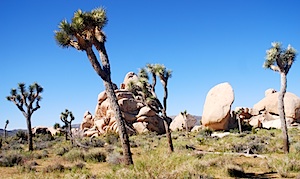
Joshua Tree National Park, Kurt Repanshek photo.
Fifty years ago, going back centuries—thereby to suspend natural processes—may have seemed good science. Today, we know that nothing about nature is permanent or perfectible. In other words, what “science” in the parks should we apply? How do we conserve natural systems that are constantly changing?
For example, as climate changes, how can we provide habitat for endangered species and maintain migration corridors? How can we prevent the invasion of non-native, unwanted species? Is it good science to build cell phone towers and other digital age technologies inside our national parks? How can the parks serve as locations for environmental research and the exploration of new genotypes while also being asked to encourage more visitors?
Should parks adjust to visitors, in other words, or should every visitor be made to honor the traditional “adjustment” never to impinge on open space?
It is no wonder this latest report rings somewhat hollow. Essentially, it says nothing new. Science is but one of the keys to saving our national parks.
A disciplined maintenance of open space against development is still the greatest challenge. On that score, we have learned the importance of other “vignettes,” including those of our national history. Among our 398 national park areas, there are 25 battlefields (9 known as military parks), 46 historical parks, and 78 historic sites -- places that can claim neither geological monuments of wonder nor major opportunities for viewing wildlife. National memorials, cemeteries, and “affiliated” areas swell those numbers even more. What the majority require, along with our natural parks, is a prerequisite respect for open space. As historians note, Gettysburg National Military Park, for example, no longer has the exact appearance or “feel” of the battlefield of 1863. The town itself has grown. In other words, without that initial commitment to a credible “vignette” so many years ago, no amount of scientific restoration today would matter. The military park can at least approximate the original battlefield because its critical woods, fields, and hills were conscientiously protected from development.
Parks For Parks' Sake
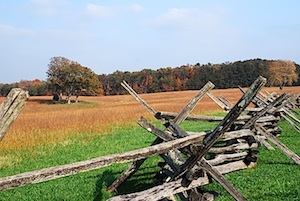
Protected fields at Mansassas National Battlefield Park, Kurt Repanshek photo.
As the Park Service centennial approaches, that is the most important thing to reaffirm. We do not need to remake our parks in anyone’s image; rather, we need to remind ourselves why the traditional image continues to work so well. Simply put, parks instill discipline.
The singular achievement of parks is preventing development—withholding open space from mindless change—so that civilization maintains some humility over its power to change everything else. That is also the imperative of parks abroad—in another 187 countries at last count. Those nations may not fully understand it either, but protected lands—a commitment to discipline—is the best thing our national park idea has ever taught.
That is what the National Park Service should be celebrating. There is no need to reinvent the national park idea; a permanent respect for open space says it all.
If parks exist, scientific principles can be added at any time—or any other principle, for that matter. However, if parks did not exist, all such opportunities would be lost.
Among environmental historians, a favorite example is Central Park. Imagine New York City today without it, that is, without its inspiration as open space. Shortly after its dedication in 1858, its co-designer, Frederick Law Olmsted, helped carry the park idea to Yosemite Valley. By then, in 1864, Yosemite had been seen by perhaps a thousand people. No matter, so long as it remained open space, Americans would in time discover it.
Within a century, Olmsted predicted, millions would be visiting Yosemite Valley, and no longer just the rich. “[Those] millions who are hereafter to benefit by the Yosemite Act have the largest interest in it,” he wrote, “and the largest interest should be first and most strenuously guarded.”
Halfway through that coming century, Joseph Grinnell and Tracey I. Storer were among those arguing that Yosemite’s mandate was incomplete. The point is that what they wished to add as scientists—an abiding respect for wildlife as well as scenery—could not have been added without Olmsted’s initial efforts [and John Muir’s campaign in 1890 to expand the park], first protecting Yosemite as open space.
Appreciate The Value Of Parks
The point endures: Without parks, our country would have developed haphazardly, and would by now perhaps be egregiously developed. From whence would have come the inspiration for state parks, forest reserves, wilderness, and national wildlife refuges?
And yes, the hallowed ground of our magnificent historylands, as American Heritage magazine once described them? Thanks to our national parks, we at least developed a conscience about what we should and should not do to the land.
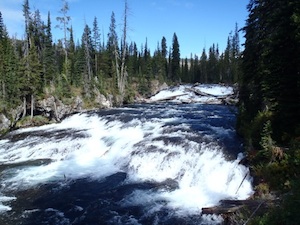
Cascades along the Bechler River, Yellowstone National Park, Kurt Repanshek photo.
Even today, there are many nibblers who would like to take a bite out of Central Park. They promise it would be a small bite, but by now the people of New York know better. It is the same with national parks. Because our pledge to the land is permanent, developers know what the American people will never approve.
Or do developers know that, and again, what happens should we fail to renew our original mandate? Will Americans of the future retain our historical idealism for the protection of open space? Will they—as we—remain gladdened to follow in the footsteps of Jefferson, Olmsted, and Muir, recognizing that a forward-thinking country demands a respect for natural landscapes?
Rather than keep trying to “improve” on the national parks, we need first of all to take care of them as they are. Will the latest recommendation to hire more scientists help the parks? Not if the parks are continually pressured to absorb our latest frivolities, whatever they may be.
In the protection of open space, any development is ultimately frivolous. Yes, we need places to eat and sleep. We need reasonable access and visitor protection. But cell phone towers, for example, we do not need if all we do is twitter and tweet.
Even with those so-called advances in communication, there will be accidents in the parks. Being able to instantly call for help is no excuse for demanding that nature become our final distraction. In parks, civilization is supposed to be subdued and every visitor concomitantly at risk. Even at home, millions of Americans accept that risk every day by living beyond the limits of immediate emergency services. In parks, civilization is supposed to be patient, and not the other way around. Open space can absorb a lot, but every individual want and desire it can never absorb.
A final warning: No park should be asked to become a soldier in the war against climate change. There are other lands better suited to experimenting with green energy. The national parks should endure as their founders envisioned—as “the best idea we ever had.”
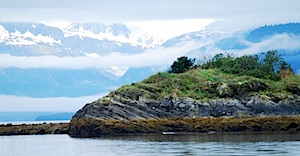
Glacier Bay National Park, Kurt Repanshek photo.
A best idea should never make room for poor ideas, of which losing the land to anything is the worst of all. In reminding Americans of that, the National Park Service may have a centennial it can be proud of.
Vision seldom arises from new reports and committees, especially those picked for some occasion. Vision is serendipitous and comes from the heart. This is to remind us why the national park idea has a heart so bold and true. We love it for its ability to rise above our mistakes, and yes, our abuses. Then let us not mistake what it really is. The protection of open space, as defined by space itself, is still our greatest gift to the world and to ourselves.
A lifelong naturalist, Daniel Botkin writes about the balance of nature as a human concept. His latest book, just released by Oxford University Press, is The Moon in the Nautilus Shell: Discordant Harmonies Reconsidered. Dr. Botkin has also taught at Rutgers, Yale, and the University of California, Santa Barbara, where he is emeritus professor of biology and chair emeritus of environmental studies. Alfred Runte, an environmental historian, specializes in the national parks and protected lands. His recent titles are National Parks: The American Experience (Taylor Trade Publishing), now in its fourth edition, and the fifth edition of his Trains of Discovery: Railroads and the Legacy of Our National Parks (Roberts Rinehart).

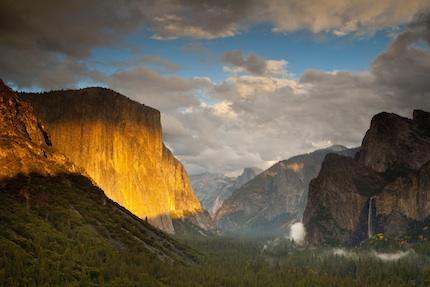


Comments
That's not what the passage says. It says "science-informed prudence and restraint," which is clearly very different.
Like I said justin - some want to use the science when it supports their "prudence and restraint" You only reinforce that idea. "science-informed prudence and restraint" read literally means that the decision isn't based on science at all.
To read it "literally," here's a website that might help. It reviews how nouns and adjectives function in a sentence: http://www.iscribe.org/english/index.html
So typical of those that can't maintain the discussion. Point to dictionaries and their Funk and Wagnall.
So tell us - what does the adjective "science informed" mean? It means the decision maker is aware of the "science" but it has no control over the decision - that is left to "prudence and constraint" Banning the bike race at CNM is a prime example. What is the scientific basis for that ban?
Well, FF, I assume you must be trolling here. In any case, let me walk you through the basic literacy of the phrase "science-informed prudence and restraint":
Inform - “to play an essential part in determining the nature, shape, or structure of”
Hence,
Science that plays an essential part in determining the nature, shape, or structure of prudence and restraint.
And what is the science used to block the bike race at CNM?
FF, as we previously noted, the decision not to allow the race was due primarily to the National Park Service's prohibition against commercial events that award significant prizes, that don't have meaningful connections to the park's purpose, and would pose a conflict with visitors in the park to enjoy the park, not to watch a bike race.
FF--It's hard to keep up with your leaping from one topic to the next. The bike race was denied at Colorado NM based on policy and law. As has clearly been stated on this blog, the 2006 policies state that a special event in an NPS area must have a meaningful association with the park area and must contribute substantially to visitor understanding of the area. Title 36 of the Code of Federal states that a permit must be denied for an event that serves the interests of a for-profit organization or awards more than nominal prizes to its participants. The bike race fails all those criteria. What's so hard about understanding that?
Rick